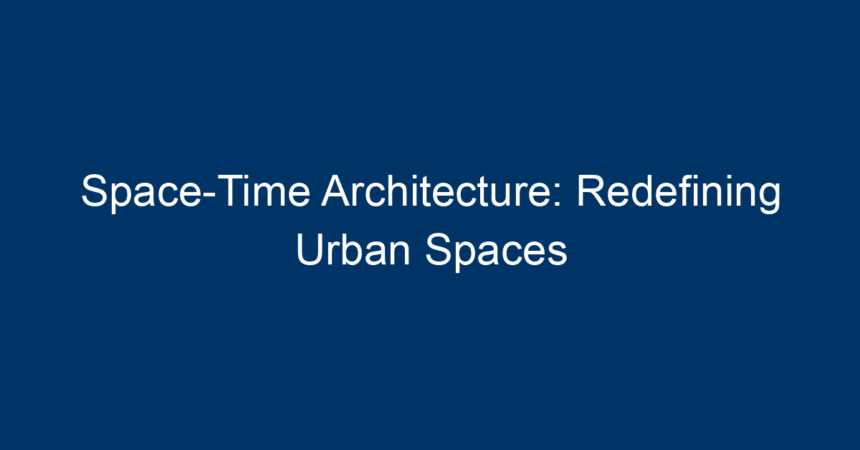In an era where technological advancements and environmental considerations are reshaping our cities, the concept of space-time architecture is pioneering a new narrative for urban design. This innovative framework bridges the gap between our physical space and the time we spend in it, encouraging a holistic approach to how we inhabit, interact with, and visualize our environments. As urban areas continue to expand and evolve, understanding space-time architecture becomes crucial for creating sustainable, functional, and dynamic communities.
The Essence of Space-Time Architecture
Understanding the Concept
Space-time architecture integrates two fundamental elements: spatial design and temporal experiences. It challenges the conventional views of architecture by emphasizing not only the static physical structures but also the dynamic interactions that occur within them over time. This dual focus allows architects and urban planners to create spaces that adapt to the needs of their inhabitants, fostering a sense of connection and belonging.
Historical Context
Historically, architecture has revolved around the physical form of buildings. From ancient civilizations erecting monumental structures to modern skyscrapers defining city skylines, the focus has primarily been on aesthetics, functionality, and durability. However, as cities have grown denser and more complex, the need for a more adaptable approach became evident. The rise of digital technology and the increasing importance of sustainability have further catalyzed the emergence of space-time architecture.
The Key Components of Space-Time Architecture
Flexible Spaces
One of the fundamental tenets of space-time architecture is the creation of flexible spaces. These are environments that can adapt to multiple uses and user needs. For instance, a community center designed with movable walls can serve as a meeting space during the day and transform into an event venue at night. This adaptability not only maximizes utility but also encourages community engagement by accommodating various activities.
Temporal Dynamics
Another critical aspect is the temporal dynamics of a space. This refers to how a space changes over time, influenced by factors such as usage patterns, lighting, and even the seasons. Incorporating elements like dynamic facades that adjust based on sunlight or passive heating strategies can enhance energy efficiency, creating a sustainable built environment. Understanding how users move through and interact with spaces also contributes to the overall experience of those environments.
Community-Centric Design
At the heart of space-time architecture lies a commitment to community-centric design. Architects and urban planners are increasingly focusing on the social fabric of neighborhoods, prioritizing spaces that foster interaction and inclusivity. Community gardens, open parks, and shared public plazas are all examples of how urban areas can benefit from a design philosophy that values human connection and collaboration.
The Role of Technology in Space-Time Architecture
Digital Integration
The advancement of technology plays a significant role in the evolution of space-time architecture. Building Information Modeling (BIM) and augmented reality (AR) tools enable architects to visualize and simulate spaces before they are built. This not only streamlines the design process but also allows for real-time adjustments based on user feedback. As a result, urban spaces can be tailored more effectively to meet the diverse needs of their inhabitants.
Smart Cities
The concept of smart cities is closely tied to space-time architecture. By incorporating IoT (Internet of Things) technology, urban planners can create connected environments that respond to the needs of users in real-time. This may include smart lighting that adjusts based on occupancy or traffic systems that optimize the flow of pedestrians and vehicles. Such responsiveness contributes to a more efficient and pleasant urban experience.
Real-World Applications of Space-Time Architecture
Case Studies
-
The High Line, New York City: Once an abandoned railway line, this linear park exemplifies the principles of space-time architecture. By transforming an underutilized space into a vibrant green corridor, the High Line has become a focal point for community activity, encouraging social interaction and urban biodiversity.
-
The Bosco Verticale, Milan: This mixed-use residential project incorporates vertical gardens that change with the seasons, demonstrating the dynamic characteristics of space-time architecture. The building not only provides housing but also creates a lush green environment that improves air quality and enhances the urban experience.
- Gamble House, Pasadena: A model of the Arts and Crafts movement, this historical home embodies time-based design principles. Its layout encourages natural light flow and outdoor interaction seasons; thus, it highlights the importance of yearly cycles in residential architecture.
Challenges and Considerations
Balancing Tradition and Innovation
While the principles of space-time architecture offer numerous advantages, they also present challenges. Striking a balance between traditional architectural styles and innovative design practices can be complex. Urban planners must consider historical preservation alongside the need for modernization, ensuring that new developments respect the existing cultural landscape.
Environmental Sustainability
Environmental sustainability is another critical challenge. As urban areas expand, the pressures on natural resources increase. Space-time architecture must not only strive for aesthetic and functional excellence but also address ecological impacts. Utilizing renewable materials, reducing carbon footprints, and promoting biodiversity through green roofs are essential strategies for creating sustainable urban environments.
Actionable Insights for Urban Designers
Embrace Multi-Functionality
Design spaces that can serve multiple purposes to maximize utilization. Consider how rooms can change function based on user needs and the time of day.
Incorporate Natural Elements
Integrate nature into urban environments to create a balance between built and natural spaces. This can promote well-being and improve the overall quality of life for residents.
Utilize Technology Responsively
Invest in smart technologies that enhance user experience. Implementing responsive systems not only improves functionality but also contributes to a more sustainable urban environment.
Engage the Community
Involve community stakeholders in the design process. Engaging local residents ensures that developments meet genuine needs, fostering a sense of ownership and belonging in urban spaces.
Conclusion
Space-time architecture is redefining urban planning and design, creating dynamic, responsive environments that cater to the needs of modern city dwellers. By embracing flexibility, community-centricity, and technological integration, urban spaces can transform into vibrant ecosystems that enhance quality of life. As cities continue to grow and evolve, applying the principles of space-time architecture will be vital for creating sustainable, adaptable, and inclusive communities. Embrace this innovative approach and join the movement towards a future where our urban landscapes thrive harmoniously with the rhythms of life.




